One Nation, One Election
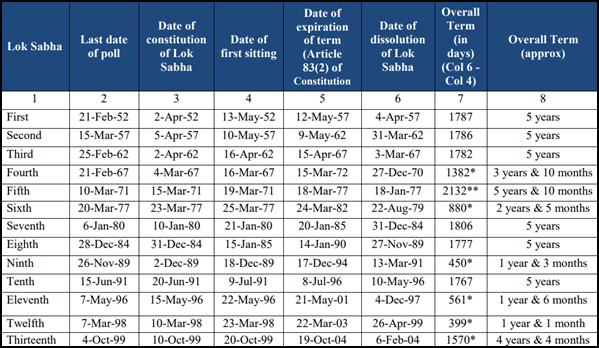
- 19 Dec 2024
In News:
The government has recently taken steps to implement "One Nation, One Election" by presenting two Constitution Amendment Bills in the Lok Sabha: the One Nation One Election – The Constitution 129th Amendment Bill 2024 and the Union Territories Laws Amendment Bill 2024.
Introduction to the Concept:
- Objective: Proposes synchronizing elections for Lok Sabha (national) and State Legislative Assemblies to be held on the same day.
- Purpose: Aims to reduce costs, minimize logistical challenges, and address governance disruptions caused by frequent elections.
- 2024 Report: The High-Level Committee Report on Simultaneous Elections, released in December 2024, outlines a roadmap for implementing this reform.
Historical Background:
- Previous Practice: From 1951 to 1967, Lok Sabha and State Assembly elections were conducted together.
- Disruptions: The practice was interrupted due to premature dissolutions and emergencies, leading to staggered elections across India.
High-Level Committee on Simultaneous Elections:
- Committee Formation: Headed by former President Ram Nath Kovind, formed on 2nd September 2023.
- Public Response: Over 21,500 responses, with 80% in favor.
- Political Party Responses: 32 political parties supported the idea, while 15 raised concerns about regional party marginalization.
- Expert Consultations: Majority of experts supported the reform, emphasizing resource optimization and reduced disruptions.
Committee Recommendations:
- Constitutional Amendments: Proposals to amend Articles 82A and 324A to enable simultaneous elections.
- Two-Phase Implementation:
- Phase 1: Synchronize elections for Lok Sabha and State Legislative Assemblies.
- Phase 2: Include Municipalities and Panchayats within 100 days.
- Single Electoral Roll: Creation of a unified electoral roll and EPIC for all levels of elections, reducing duplication and errors.
Rationale for Simultaneous Elections:
- Governance Consistency: Reduces focus on election preparation, allowing more attention to developmental work.
- Prevents Policy Paralysis: Mitigates disruptions caused by the Model Code of Conduct (MCC) during frequent elections.
- Resource Optimization: Reduces the need for personnel and resources for election duties, allowing better allocation to governance tasks.
- Preserves Regional Party Relevance: Local issues remain prioritized, ensuring regional parties' concerns are heard.
- Equitable Political Opportunities: Encourages diversification and inclusivity within political parties.
- Financial Benefits: Reduces the financial burden of conducting multiple elections, enhancing economic efficiency.
Conclusion:
- The concept of "One Nation, One Election" is a significant reform aimed at streamlining India's electoral processes. With broad public and political support, it promises improved governance, cost savings, and better resource management in the future.
One Nation, One Election Bill
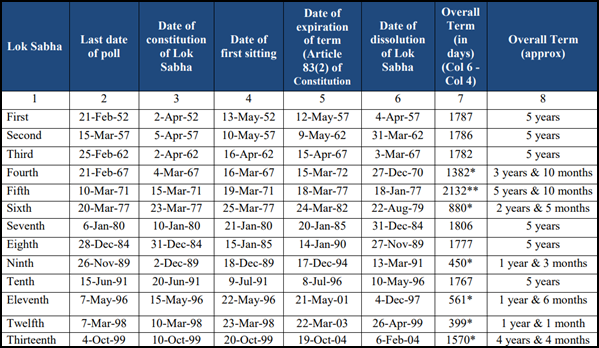
- 13 Dec 2024
In News:
The One Nation, One Election Bill has made significant progress in India, passing the Lok Sabha with 269 votes in favor and 198 votes against. The bill proposes the synchronization of elections for the Lok Sabha, State Legislative Assemblies, and local bodies (Panchayats and Municipalities), aiming to streamline the electoral process, reduce costs, and enhance governance.
Key Updates:
- The bill has been approved by the Union Cabinet and will be reviewed by a Joint Parliamentary Committee (JPC), whose report will be presented for further approval and discussion in Parliament.
- The process will unfold in two phases:
- Phase 1: Simultaneous elections for the Lok Sabha and State Legislative Assemblies.
- Phase 2: Synchronizing local body elections (Panchayats and Municipalities) within 100 days of the general elections.
Historical Context:
- 1951-1967: India previously conducted simultaneous elections for the Lok Sabha and State Assemblies until disruptions, such as premature dissolutions of assemblies, led to staggered elections after 1967.
- The One Nation One Election concept has been revived to address inefficiencies in the current system, especially the high cost of conducting frequent elections.
Advantages of the One Nation, One Election Bill:
- Cost Reduction: Synchronizing elections can significantly lower the financial burden by eliminating the need for multiple election cycles, reducing the deployment of resources like security personnel and election staff.
- Long-Term Governance Focus: Politicians can prioritize governance and policy implementation rather than election campaigning, fostering long-term stability.
- Increased Voter Turnout: Voter fatigue, caused by frequent elections, may reduce, leading to higher turnout as elections occur less often.
- Fairer Political Competition: Smaller regional parties could have a better chance to compete with larger national parties by reducing election-related costs.
- Efficient Use of Resources: Security forces and administrative resources can be deployed more effectively, avoiding the redundancy caused by multiple election cycles.
Disadvantages of the One Nation, One Election Bill:
- Synchronization Challenges: Aligning elections across a vast and diverse country like India, especially in states with unstable political situations, may prove difficult.
- Federalism Concerns: The implementation may require constitutional changes that could impact India's federal structure, potentially limiting the autonomy of states in election matters.
- Impact on Regional Issues: National issues could overshadow regional concerns, diluting the focus on state-specific matters.
- Challenges for Regional Parties: Larger national parties may dominate the electoral landscape, reducing the influence of regional parties and undermining the federal nature of the political system.
- Accountability Risks: Fixed terms without frequent elections might reduce public scrutiny of elected officials, affecting their accountability.
Constitutional Amendments Required:
The implementation of One Nation, One Election requires amendments to several key constitutional provisions:
- Article 83: Regarding the duration of the Lok Sabha, amendments are needed to synchronize the timing of dissolution.
- Article 85: Deals with the sessions and dissolution of Parliament, which needs to be aligned with the new system.
- Article 172: Pertains to the duration of State Legislatures, requiring amendments for synchronization.
- Article 174: Similar to Article 85, it governs the sessions and dissolution of State Legislatures, needing standardization.
Implementation Challenges:
- Logistical Complexity: Conducting simultaneous elections would require immense logistical coordination, including vast numbers of electronic voting machines and trained personnel.
- Political Accountability: Fixed terms may reduce the accountability that frequent elections bring, potentially leading to governance stagnation.
- Impact on Federalism: Amendments to the Constitution regarding state legislatures might face resistance from states concerned about their autonomy.
One Nation One Subscription (ONOS)
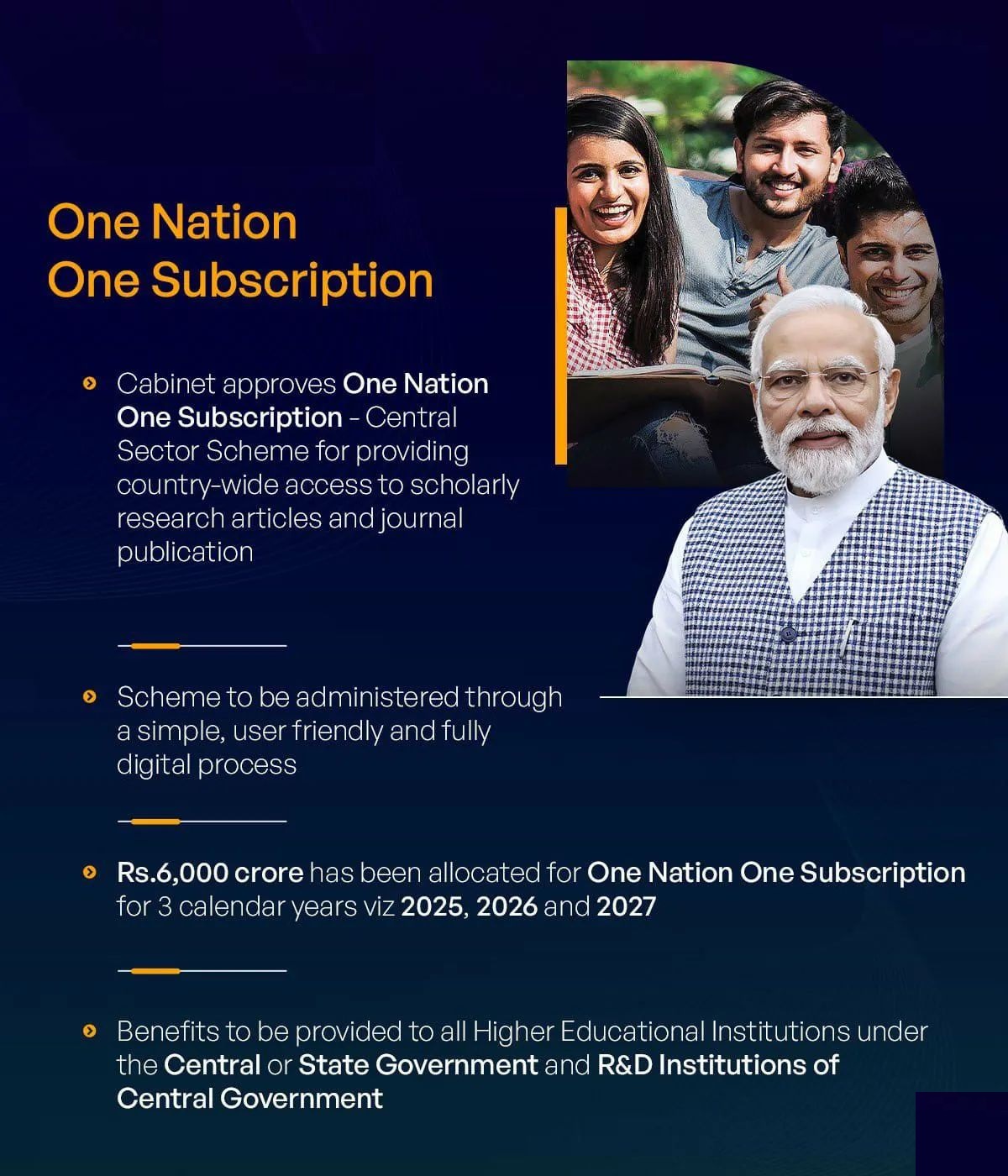
- 26 Nov 2024
In News:
Cabinet approves One Nation One Subscription (ONOS) Scheme.
Key Highlights:
- Objective: It is a new initiative to provide unified access to international scholarly research articles and journals for all government-managed higher education institutions and research institutions in India.
- Scheme Overview:ONOS aims to make nearly 13,000 scholarly journals accessible to over 1.8 crore students, faculty, researchers, and scientists in more than 6,300 institutions across India. These journals will cover all academic disciplines, promoting both core and interdisciplinary research, including in tier 2 and tier 3 cities.
- Digital Platform:The scheme will be implemented through a fully digital process, coordinated by the Information and Library Network (INFLIBNET), an autonomous center under the University Grants Commission (UGC). The platform will provide easy access to the journals and facilitate a streamlined subscription process.
- Investment and Coverage:A total of ?6,000 crore has been allocated for ONOS for three years (2025-2027). The scheme will cover major international publishers such as Elsevier, Springer, Wiley, and Oxford University Press. It will enable institutions to access 13,000 journals from 30 global publishers.
Benefits of the Scheme:
- Access to Top-Quality Research:ONOS will provide wide access to top-tier scholarly journals, benefiting institutions, researchers, and students across various fields. It will significantly improve the research environment in the country, especially for institutions that previously lacked the resources to access high-impact journals.
- Fostering Research and Development:The initiative aligns with India's vision of becoming an Atmanirbhar and Viksit Bharat by 2047, supporting the government's goals under the National Education Policy (NEP) 2020 and the Anusandhan National Research Foundation (ANRF). It will help foster a culture of research and innovation in Indian institutions.
- Inclusivity:The scheme will particularly benefit institutions in smaller towns and rural areas, helping bridge the knowledge gap between urban and rural academic institutions.
- Simplified Access:The scheme eliminates the need for separate subscriptions to individual journals by different institutions, streamlining access to high-quality content through a single platform.
Implementation Details:
- Platform and Process:The ONOS platform will allow institutions to access journals through a unified portal, providing easy and coordinated access. The Department of Higher Education (DHE)will be responsible for conducting awareness campaigns about the initiative, ensuring widespread utilization among students and faculty.
- Review Mechanism:The ANRF will monitor and periodically review the usage of ONOS and track the contributions of Indian authors in the journals, ensuring that the initiative continues to support India’s research landscape.
- Operational Date:The ONOS platform is set to become operational on January 1, 2025, providing comprehensive access to research materials for government-managed higher education and research institutions.
The One Nation One Subscription scheme is a major step towards enhancing India's position in the global research ecosystem. It will provide unparalleled access to scholarly resources, supporting research excellence and innovation across the country.
One Nation, One Election
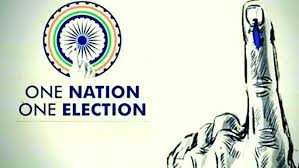
- 19 Sep 2024
In News:
The Union cabinet has recently approved the "One Nation, One Election" proposal, facilitating the conduct of simultaneous elections in India. This initiative follows a report submitted in March by a high-level committee chaired by former President Ram Nath Kovind, which unanimously recommended synchronizing Lok Sabha and State Assembly elections, along with local body polls, within 100 days.
What are Simultaneous Polls?
Simultaneous polls aim to align the timing of Lok Sabha and State Assembly elections across all states, thereby reducing the frequency of elections. Historically, simultaneous elections were held during the first four general election cycles (1952, 1957, 1962, and 1967), but this practice ended in 1959 after the dismissal of the Kerala government. Since then, due to premature dissolutions of various Assemblies, elections have been staggered. Currently, only four states—Andhra Pradesh, Odisha, Arunachal Pradesh, and Sikkim—hold simultaneous elections with the Lok Sabha.
Arguments For and Against
Proponents argue that simultaneous elections can significantly reduce election-related costs, which amounted to approximately ?3,870 crore during the 2014 general elections. They also highlight that the Model Code of Conduct triggers twice in a five-year cycle, leading to extended periods of governance downtime.
Opponents caution that this approach may favor larger political parties with national reach, potentially sidelining smaller regional parties. A 2015 study found that the likelihood of a party winning both Lok Sabha and Assembly elections when held simultaneously is 77%, dropping to 61% if elections are spaced six months apart.
Implementation Process
The committee proposed a two-step implementation:
- Simultaneous Elections: Conduct elections for both the Lok Sabha and State Legislative Assemblies together.
- Synchronizing Local Elections: Hold elections for municipalities and panchayats within 100 days following the general elections.
Following the announcement of the "appointed date," the terms of all State Assemblies constituted after that date would end with the Lok Sabha's term. This could lead to most State governments not completing their five-year terms, even if they maintain a majority.
Required Constitutional Changes
Several amendments to the Constitution have been proposed:
- Introduction of Article 82A: This would require all Legislative Assemblies elected after the appointed date to conclude with the Lok Sabha’s term.
- Amendment of Article 327: Expanding Parliament's powers to include the conduct of simultaneous elections.
- Revisions to Articles 83 and 172: Defining the five-year term as the "full term" and any remaining period after premature dissolution as the "unexpired term."
- Introduction of Article 324A: Empowering Parliament to ensure that municipality and panchayat elections occur alongside general elections.
- Amendments for Union Territories: Ensuring that Assembly elections in Union Territories align with simultaneous elections.
- Single Electoral Roll: Proposing a common electoral roll for all elections, to be managed by the Election Commission of India (ECI).
State Ratification
Under Article 368, amending the Constitution may require ratification by state legislatures. The panel believes that syncing Assembly elections with Lok Sabha elections will not need state ratification, but amendments for a common electoral roll and synchronization of local elections will require cooperation from the states. The ruling BJP, currently in power in several states, will need to navigate upcoming Assembly elections in Haryana, Maharashtra, and Jharkhand to secure this support.
Conclusion
The "One Nation, One Election" initiative aims to streamline India's electoral process, potentially enhancing governance and reducing costs. However, its success depends on achieving political consensus and implementing necessary constitutional amendments, which will require collaboration among various political parties and state governments.
One Nation, One Registration Platform (The Hindu)
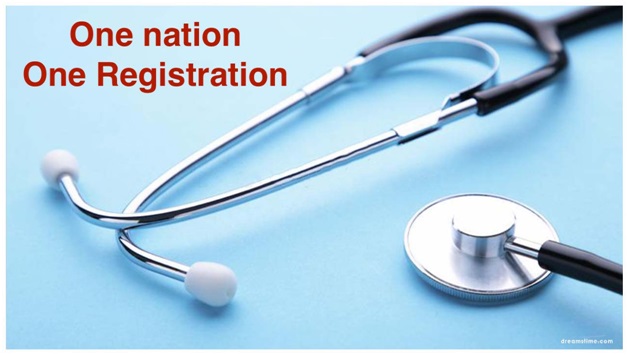
- 01 Nov 2023
Why in the News?
The National Medical Commission (NMC)will launch its “One Nation, one registration platform’‘ for doctors across the country
About One Nation, One Registration Platform:
- The National Medical Commission (NMC) will launch a patch trial of the National Medical Register (NMR), in which physicians will receive a unique identification number and, based on their location, be able to apply for a license to practice in any State within the next six months.
- The change was announced by the commission in a gazette notification earlier this year under the title "Registration of Medical Practitioners and Licence to Practice Medicine Regulations, 2023."
- The NMR will receive the data of almost 14 lakh doctors who are currently registered in the system.
- Objectives: The goal is to supply undergraduate students on the NMR with a masked ID, and based on when they complete their course, the ID is unmasked and assigned.
- It will eliminate duplication and red tape while also providing the public with access to information on any physician practising in India.
Features of the NMR:
- The public will have access to the NMR via the NMC website, which will take the role of the current Indian Medical Register (IMR). It will provide detailed information about registered doctors, such as:
- Unique Identification Number (UID): Each doctor will be assigned a unique identification number.
- Registration Number: The doctor’s registration number for verification.
- Qualifications: Information about the doctor’s educational qualifications.
- Specialization: The doctor’s area of expertise.
- Name and Place of Work: Details of the doctor’s name and workplace.
- Institute/University: The name of the institution or university where the qualifications were obtained.
